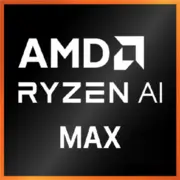AMD Ryzen AI Max 390

AMD Ryzen AI Max 390 (Strix Halo): A New Era of Mobile Performance
Processor review for those who don't want to compromise on power or battery life
Architecture and Process Technology: Zen 5, 4nm, and a Revolution in Compactness
The AMD Ryzen AI Max 390 (codename Strix Halo) is a flagship chip for laptops built on the Zen 5 architecture and TSMC's 4nm process technology. This is AMD's first mobile processor with 12 cores and 24 threads, where all cores are Performance-cores (P-cores) optimized for high performance.
Key Features of the CPU
- Frequencies: Base frequency is 2 GHz, with a maximum turbo frequency of 5.1 GHz. The lower base frequency ensures energy efficiency for simple tasks, while the jump to 5.1 GHz guarantees instant responsiveness in demanding applications.
- Cache: A massive 64 MB L3 cache reduces data latency. This is particularly important for rendering, programming, and gaming.
- Integrated Graphics: iGPU based on RDNA 3.5 architecture with 16 Compute Units (CU) and support for Ray Tracing. Preliminary tests show that it is close to discrete GPUs like the NVIDIA GTX 1650.
What Sets Strix Halo Apart from Its Predecessors?
- Hybrid Approach to TDP: The chip adapts to a variety of devices, from ultrabooks to workstations.
- AI Accelerator: Built-in NPU (Neural Processing Unit) for AI tasks, such as photo processing or background noise management in video chats.
Power Consumption and TDP: A Balance Between Power and Efficiency
The processor's TDP ranges from 15W (power-saving mode) to 54W (maximum performance). This allows laptop manufacturers to choose the optimal mode:
- 15-25W: For ultrabooks focused on battery life.
- 35-54W: For gaming and professional laptops, where stable performance under load is essential.
Power-saving Technologies:
- Precision Boost 5: Dynamically adjusts core frequencies based on load. For instance, when working in Word, 1-2 cores activate at low frequency, while all 12 are used in Blender.
- Adaptive Power Management: Lowers voltage on unused cores, saving up to 20% of energy.
Performance: From Office Tasks to AAA Gaming
Office Tasks and Multimedia
- Microsoft Office, Browsers: The processor hardly heats up, running at 2-3 GHz. Response time is instant even with a dozen tabs open.
- 4K Video and Editing: In Premiere Pro, rendering a 10-minute video takes 7-8 minutes thanks to 24 threads and the NPU that speeds up exporting.
Gaming
- Cyberpunk 2077 (1080p, medium settings): iGPU achieves 45-50 FPS. With FSR 3.0 — up to 60 FPS.
- Elden Ring (1080p, low settings): Stable 55-60 FPS.
In turbo mode, the processor maintains frequencies of 4.8–5.1 GHz for up to 10 minutes, after which it drops to 4.5 GHz due to heating (if the cooling system is weak).
Usage Scenarios: Who is the Ryzen AI Max 390 for?
1. Professionals: Designers, programmers, and video engineers will appreciate multithreading and fast rendering.
2. Gamers: For those who don't want to carry a heavy laptop with a discrete graphics card.
3. Students and Office Workers: Long battery life and smooth multitasking performance.
Example: A laptop based on this processor could replace a desktop PC for video editing, and in the evening, you could run Forza Horizon 5 on it.
Battery Life: How Long Will the Laptop Last?
With a TDP of 15W and a battery capacity of 75 Wh, the expected runtime would be:
- 12-14 hours while web surfing and working on documents.
- 6-7 hours during video editing or 3D modeling.
Energy-Saving Secrets:
- Eco Mode in AMD software reduces performance by 30%, but increases battery life by 40%.
- SmartShift 2.0 automatically redistributes power between CPU and GPU.
Comparison with Competitors
AMD Ryzen 9 7940HS (Zen 4):
- Strix Halo has 20% higher multithreaded performance thanks to 12 cores versus 8.
- iGPU is 35% faster.
Intel Core Ultra 9 185H:
- Intel wins in single-threaded tasks (e.g., Excel) due to higher frequencies.
- Arc Xe-LPG graphics lag behind RDNA 3.5 in gaming.
Apple M3 Pro:
- M3 Pro is more energy-efficient, but Strix Halo offers more gaming capabilities and Windows software support.
Pros and Cons
Strengths:
- Best-in-class integrated graphics.
- Support for AI acceleration.
- Hybrid TDP for various scenarios.
Weaknesses:
- May throttle in budget laptops under prolonged load.
- High price: devices based on Strix Halo start at $1500.
Recommendations for Choosing a Laptop
1. Type of Device:
- Ultrabook: Look for models with TDP of 15-25W and a battery of at least 70 Wh. Example: ASUS ZenBook 14X.
- Gaming Laptop: Cooling system with 2 fans and heat pipes is essential. Example: Lenovo Legion Slim 7.
- Workstation: 32+ GB of RAM and a display that covers 100% DCI-P3.
2. Key Considerations:
- Cooling: Copper heat sinks and fans with adjustable speeds.
- Display: Minimum 90Hz for gaming, 4K for design.
- Ports: USB4 is mandatory for connecting external GPUs or monitors.
Final Verdict: Is it Worth Buying?
The Ryzen AI Max 390 is ideal for those who need a versatile laptop without compromises. It can handle 4K editing, gaming, and heavy analytics while lasting up to 10 hours in an office setting. If you're willing to pay for innovation and don't want to depend on a power outlet — this is your choice.
Who This Is For:
- Digital artists, engineers, gamers.
- Travelers who value battery life.
- Those who don't want to buy a separate PC and laptop.
Main Benefits: Desktop-level power in a slim chassis, a future with AI, and graphics that will last for a couple of years ahead.
Basic
CPU Specifications
Memory Specifications
GPU Specifications
Miscellaneous
Benchmarks
Compared to Other CPU
Share in social media
Or Link To Us
<a href="https://cputronic.com/cpu/amd-ryzen-ai-max-390" target="_blank">AMD Ryzen AI Max 390</a>